Linux Statistics By Market, Usage, Website Traffic And Facts (2025)
Updated · Sep 09, 2025
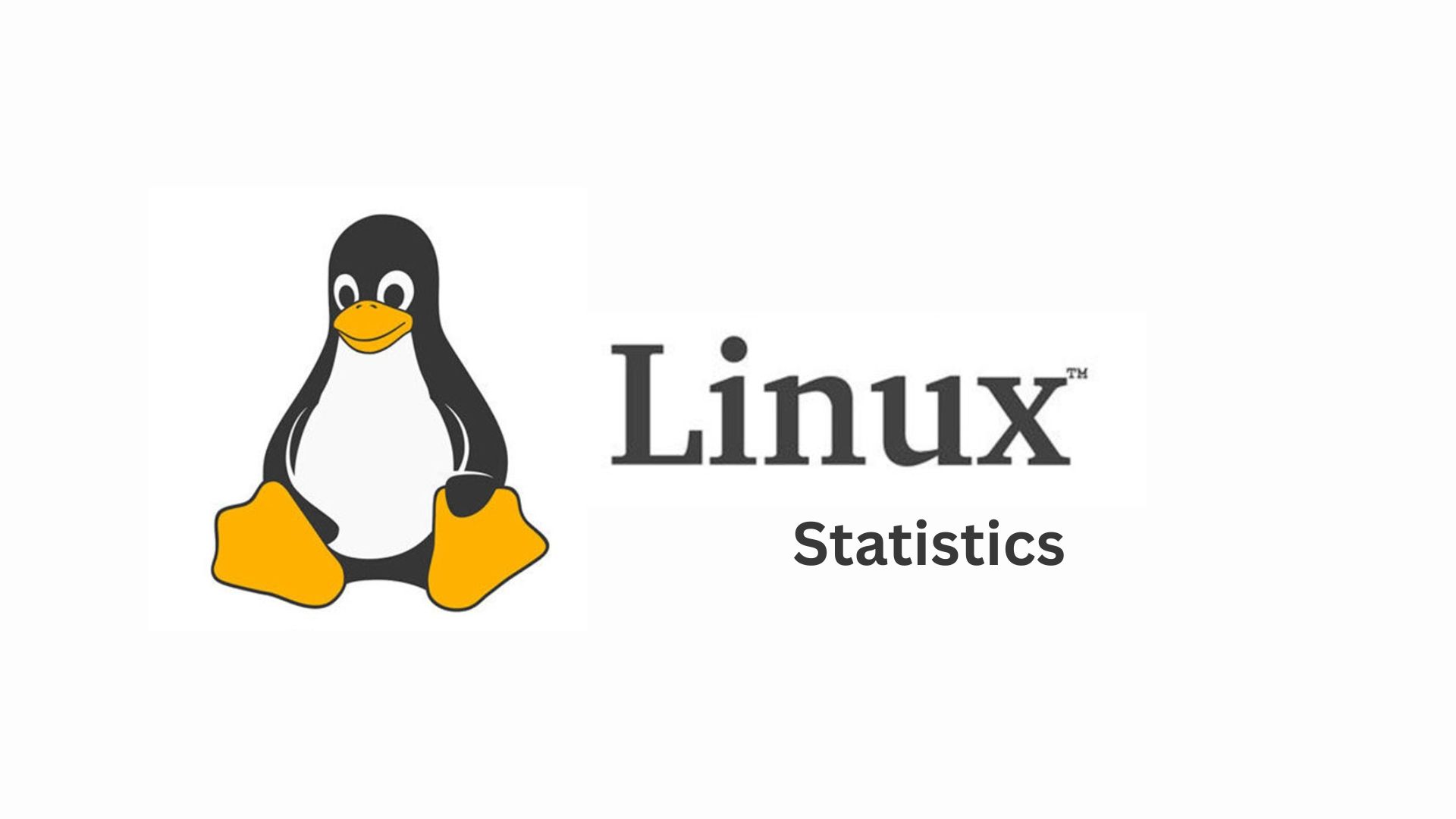
Table of Contents
- Introduction
- Editor’s Choice
- Basic Analysis of Linux
- Key Features of Linux
- Linux Market Statistics
- Linux OS Market Share Statistics
- By Region
- By Country, 2025
- Popular Linux Distributions (Distros)
- Linux Usage Statistics
- Linux Website Statistics by Ranking
- Linux Website Traffic Statistics
- 5 Key Challenges to Linux Adoption Statistics in 2025
- Advantages and Disadvantages of Linux
- Conclusion
Introduction
Linux Statistics: Linux is a group of free operating systems that work like Unix. It runs on the Linux kernel, which was first made by Linus Torvalds in 1991. Most people use Linux through something called a distribution, or distro, which is a full package that includes the kernel along with tools, software, and libraries needed to run a computer. Today, Linux is widely used in many places, from laptops and smartphones to smart TVs, servers, and even supercomputers. People like it due to its reliable, safety features, and easy customization.
This article includes several current statistical analyses from different sources, including key features, popular Linux distributions, reasons for using, use cases, how to get started, various challenges, significance in today’s world, and many others.
Editor’s Choice
- According to StatCounter report analysis, the global desktop OS market share of Linux holds 4.1 % globally as of June 2025.
- In the United States, the desktop share of Linux crossed 5.03 % in the same duration.
- linux.slashdot.org also states that Steam reported Linux usage at 2.69 % in May 2025.
- In the same period, Linux (via Android) commands 72.7 % of mobile device usage, according to Hacker News.
- Wikipedia says that Linux/Unix-like systems power approximately 77 % of web servers (as of Sept 2024).
- Smartphone penetration (Android) is reported at 85 % and approximately 72 % in different sources.
- All TOP 500 supercomputers run on Linux (100 %) as of Nov 2024.
- Coolest Gadget further states that Linux powers about 92 % of virtual machines on major cloud platforms.
- Over 25,000 developers actively contribute to the Linux kernel
- Truelist.co states that around 47% of software developers work with Linux-based operating systems in their daily tasks.
Basic Analysis of Linux
| Release Date | August 25, 1991 |
| Developer |
Community contributors, Linus Torvalds |
|
Written in |
C, assembly languages, Rust, and others |
| OS family |
Unix-like |
|
Influenced by |
Minix, Unix |
| Marketing target |
Cloud computing, embedded devices, mainframe computers, mobile devices, personal computers, servers, and supercomputers. |
|
Available in |
Multilingual |
| Kernel type |
Monolithic |
|
Userland |
util-linux by standard, various alternatives, such as Busybox, GNU, Plan 9 from User Space, and Toybox. |
| Supported platforms |
Alpha, ARC, ARM, C-Sky, Hexagon, LoongArch, m68k, Microblaze, MIPS, Nios II, OpenRISC, PA-RISC, PowerPC, RISC-V, s390, SuperH, SPARC, x86, and Xtensa. |
|
Default user interface |
Most distributions include a desktop environment (GUI). |
| License |
GPLv2 |
|
Official website |
kernel.org |
Key Features of Linux
- Linux is free to use, modify, and distribute
- Strong security model
- Stability & Reliability
- Linux can run multiple programs
- Multiuser Support
- Linux is portable, as it can run from mobile phones and smart TVs to mainframes and supercomputers.
- Customizability
- Strong Community Support
- Efficient Resource Usage
- Variety of Distributions (Distros)
Linux Market Statistics
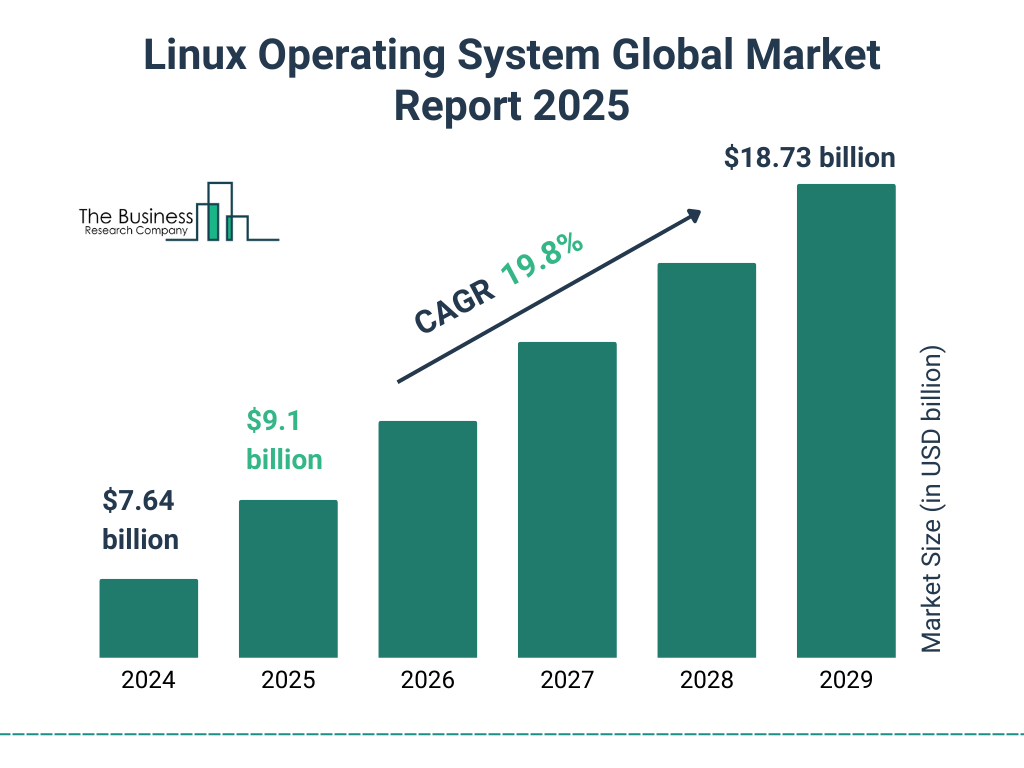
- The Linux operating system market size will grow from USD 7.64 billion in 2024 and is estimated to reach USD 9.1 billion by the end of 2025
- It will also grow to USD 18.73 billion by 2029 at a market growth rate of 19.8% CAGR.
- The Market Growth Report also states that in 2024, the Linux software market was worth USD 7.69 billion and may grow to USD 28.2 billion by 2033, rising at 15.3% yearly from 2025 onward.
- Coolest Gadget also shows that about 85% of big companies use Linux for servers, cloud, and development.
- Linux runs 80% of web servers and 70% of embedded systems, while security software demand grew 18% in 2024.
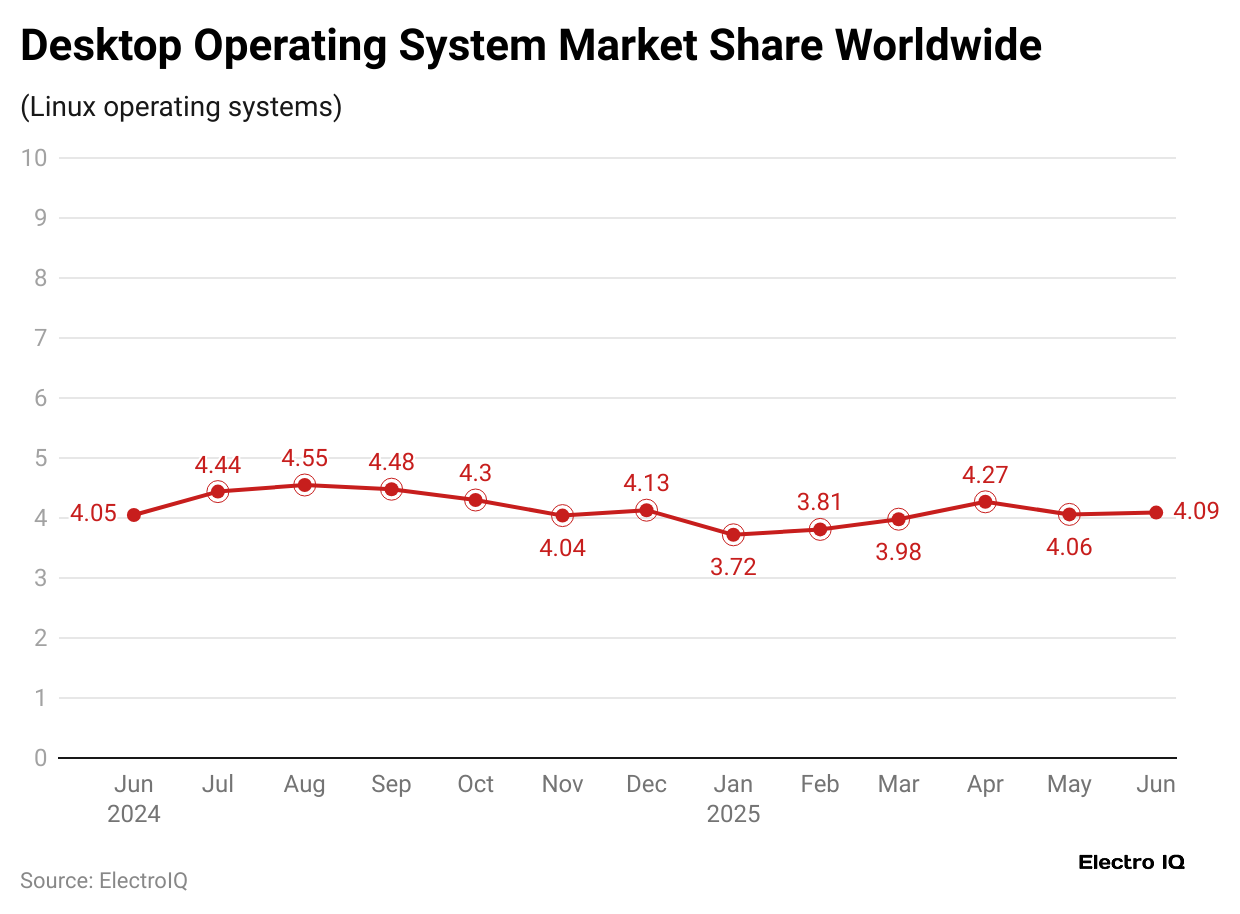
- As of June 2025, the Linux desktop operating system market share has accounted for 4.09%, increased from 4.06% in May.
- Other monthly market shares in the same period were January (3.72%), February (3.81%), March (3.98%), and April (4.27%).
Furthermore, the monthly market share of Linux in 2024 is mentioned in the table below:
| Quarter | Market Share |
| December | 4.13% |
| November | 4.04% |
| October | 4.3% |
| September | 4.48% |
| August | 4.55% |
| July | 4.44% |
| June | 4.05% |
- In contrast, the Linux mobile operating system market share in June 2025 was around 0.01%.
- In the same duration, from January to May, the global mobile Linux mobile OS market shares remained at 0.01% in each month.
By Region
- According to GS.StatCounter.co, the North American region secured the highest Linux operating system market share of 2.1% in June 2025.
- Furthermore, in 2025, other monthly OS Linux market shares were May (1.95%), April (2.2%), March (2.01%), February (1.97%), and January (1.71%).
Other regions’ overall Linux market shares in 2025 are stated in the table below:
| Months | Africa | Asia | Europe | South America |
| January | 0.66% | 1.21% | 1.4% | 1.15% |
| February | 0.61% | 1.17% | 1.48% | 1.29% |
| March | 0.69% | 1.21% | 1.59% | 1.33% |
| April | 0.88% | 1.25% | 1.75% | 1.33% |
| May | 0.81% | 1.19% | 1.77% | 0.92% |
| June | 0.69% | 1.16% | 1.88% | 0.82% |
By Country, 2025
| Months | United States of America | India | Canada | Germany |
| January | 1.97% | 1.62% | 1.12% | 2% |
| February | 2.25% | 1.72% | 1.28% | 2.55% |
| March | 2.28% | 1.88% | 1.37% | 2.79% |
| April | 2.51% | 1.88% | 1.22% | 2.92% |
| May | 2.24% | 1.85% | 1.24% | 2.93% |
| June | 2.47% | 1.87% | 1.36% | 3.01% |
Popular Linux Distributions (Distros)
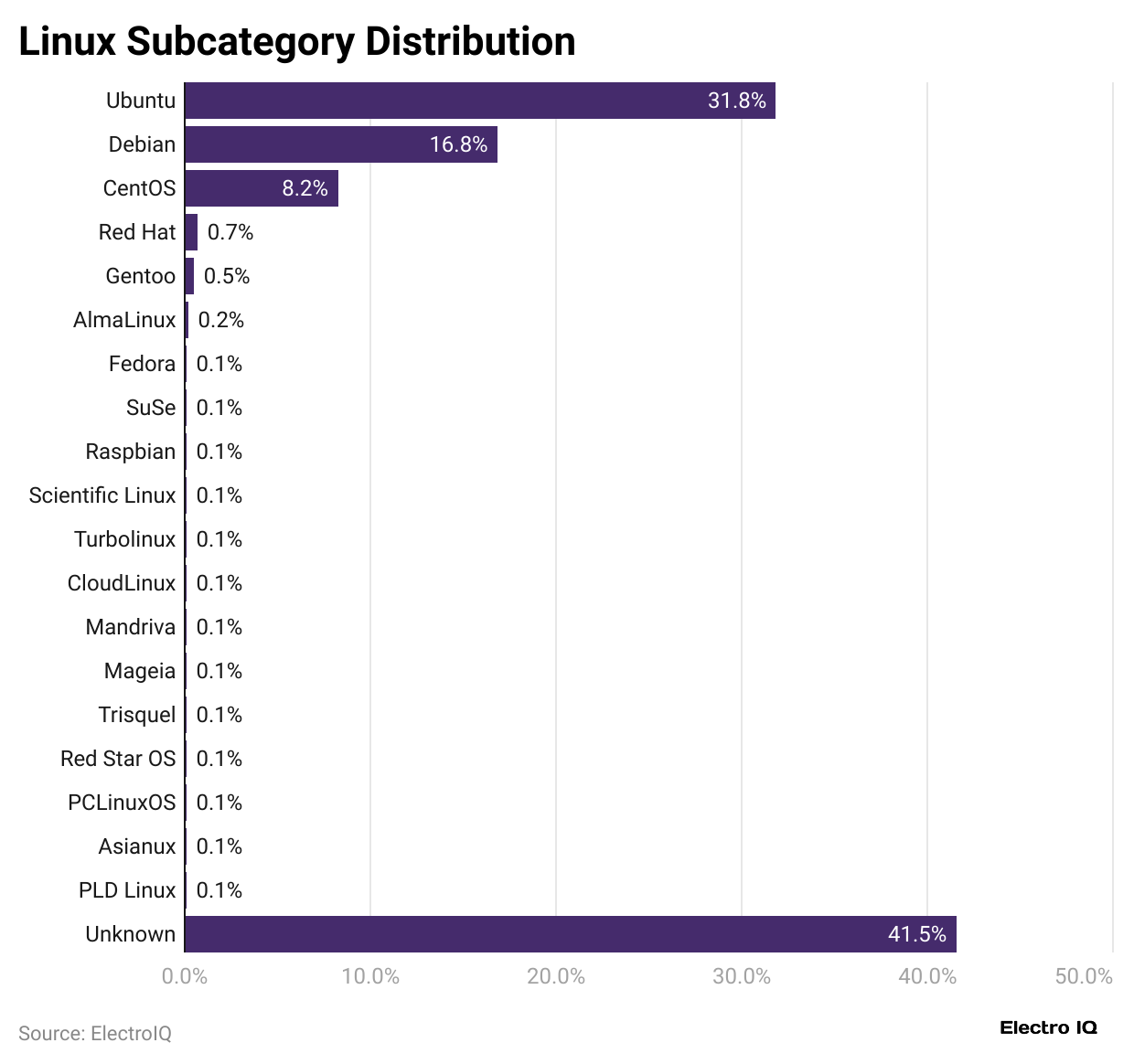
- Linux Statistics also shows that among websites that use Linux, about 31.8% use Ubuntu.
- Debian comes next with 16.8%, and CentOS is third, accounting for around 8.2% of them.
- Followed by Red Hat (0.7%), Genti (0.5%), AlmaLinux (0.2%), and SuSe (0.1%).
- Furthermore, other Linux distributions of Raspbian, Scientific Linux, Turbolinux, CloudLinux, Mandriva, Mageia, Trisquel, Red Star OS, PCLinuxOS, Asianux, PLS Linux, and Unknown all made a share of less than 0.1% each.
Linux Usage Statistics
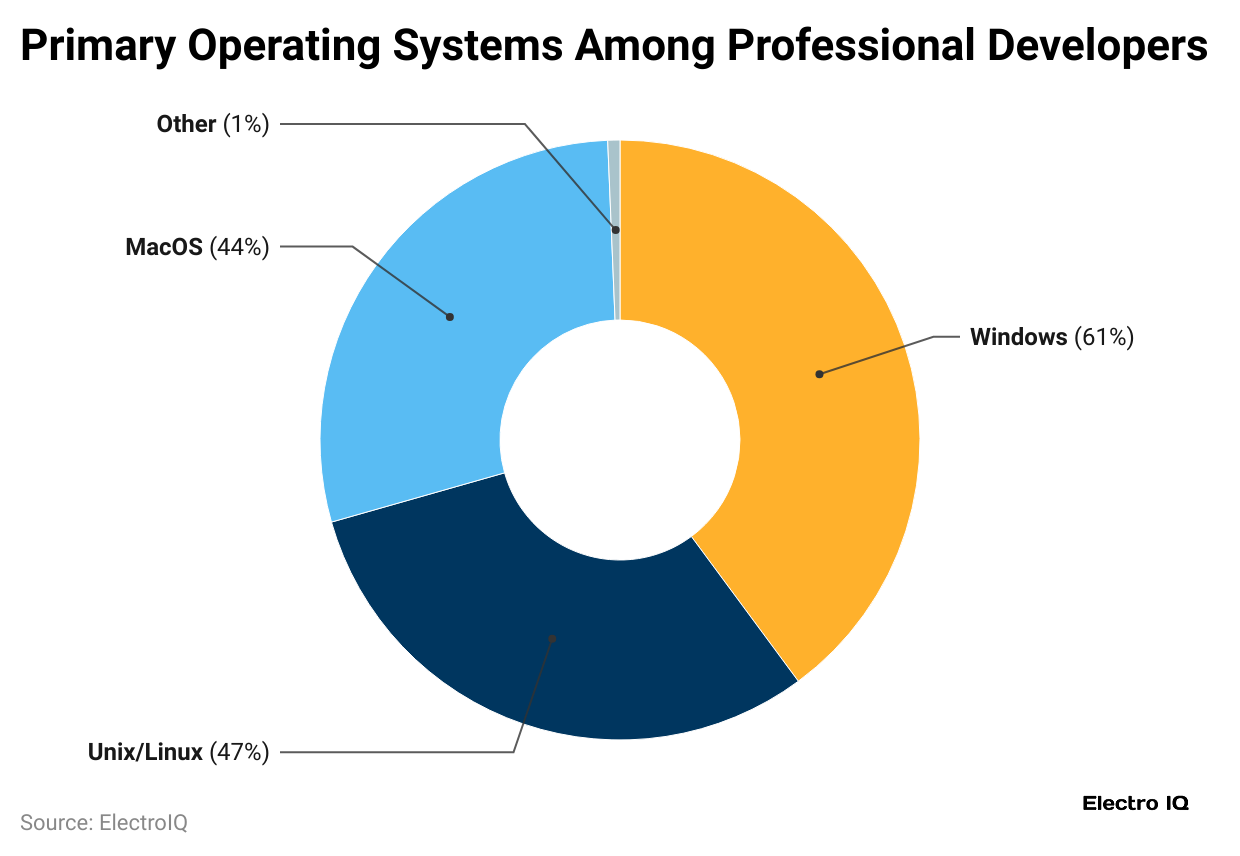
- Around 47% of software developers work with Linux-based operating systems in their daily tasks.
- As of May 2025, Linux is used on 4.04% of desktops and laptops. If you include Chrome OS, the share goes up to 5.88%.
- There are currently over 600 active Linux distributions, each serving different users and needs.
- Wikipedia says that Linux runs on nearly 77% of all web servers, and an impressive 96.3% of the top 1 million servers also use Linux.
- Every single one of the TOP500 supercomputers in the world uses Linux.
- Android, which is built on Linux, holds about 72.72% of the global smartphone operating system market.
- Between 44% to 46% of all embedded systems across the world run Linux.
- W3Techs.com further mentioned that Linux is the operating system for 57.3% of websites that reveal which OS they use.
- WifiTalents.com also depicts that about 70% of enterprise servers and data centres rely on Linux for daily operations.
- The WorldMetrics.org website also states that Linux is used for almost 90% of public cloud workloads, including services on AWS, Google Cloud, and Azure.
Linux Website Statistics by Ranking
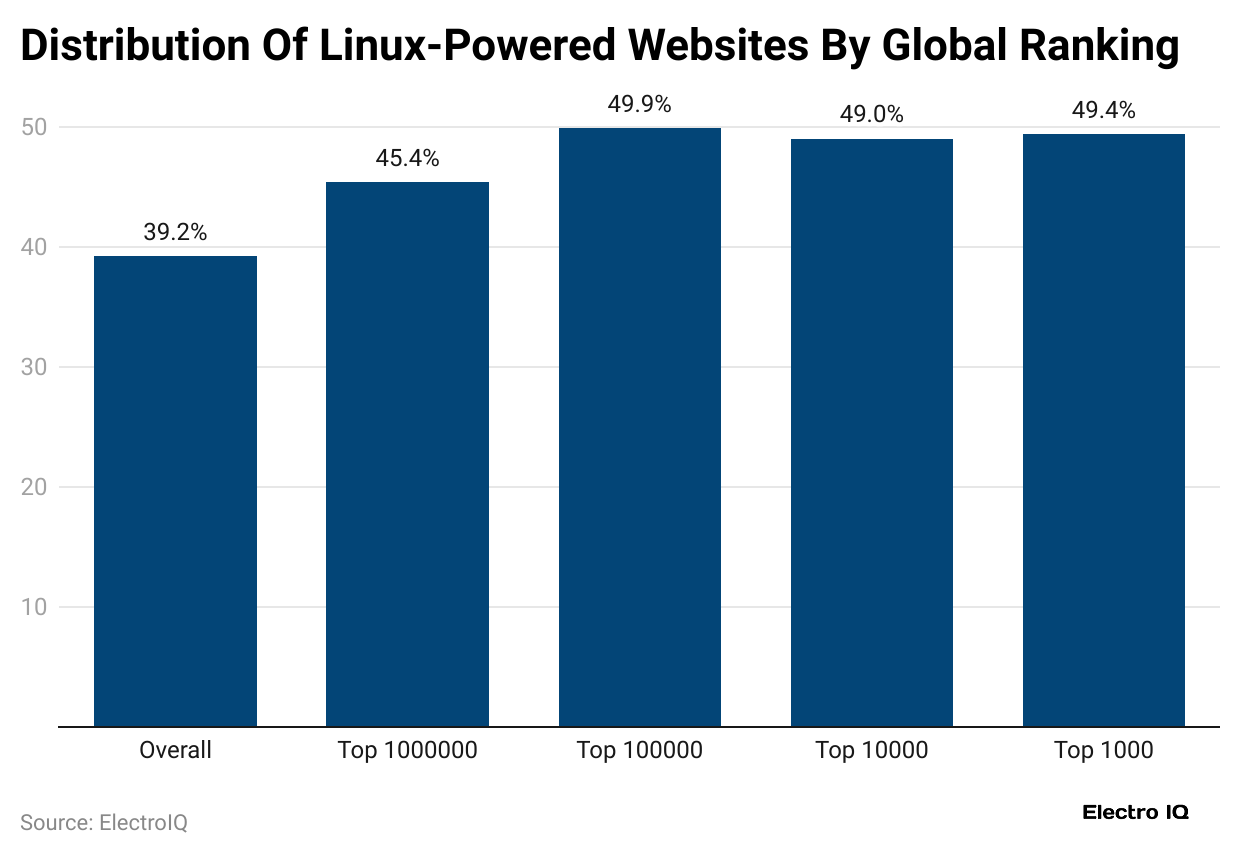
- Nearly half (49.9%) of the top 100,000 websites and about 45.4% of the top one million websites around the world use Linux as their operating system.
- Furthermore, the global ranking distribution of Linux-powered websites is followed by 49.4% (top 1,000 websites), 49% (top 10,000 websites), 45.4% (top 1,000,000 websites), and 39.2% (overall websites).
Linux Website Traffic Statistics
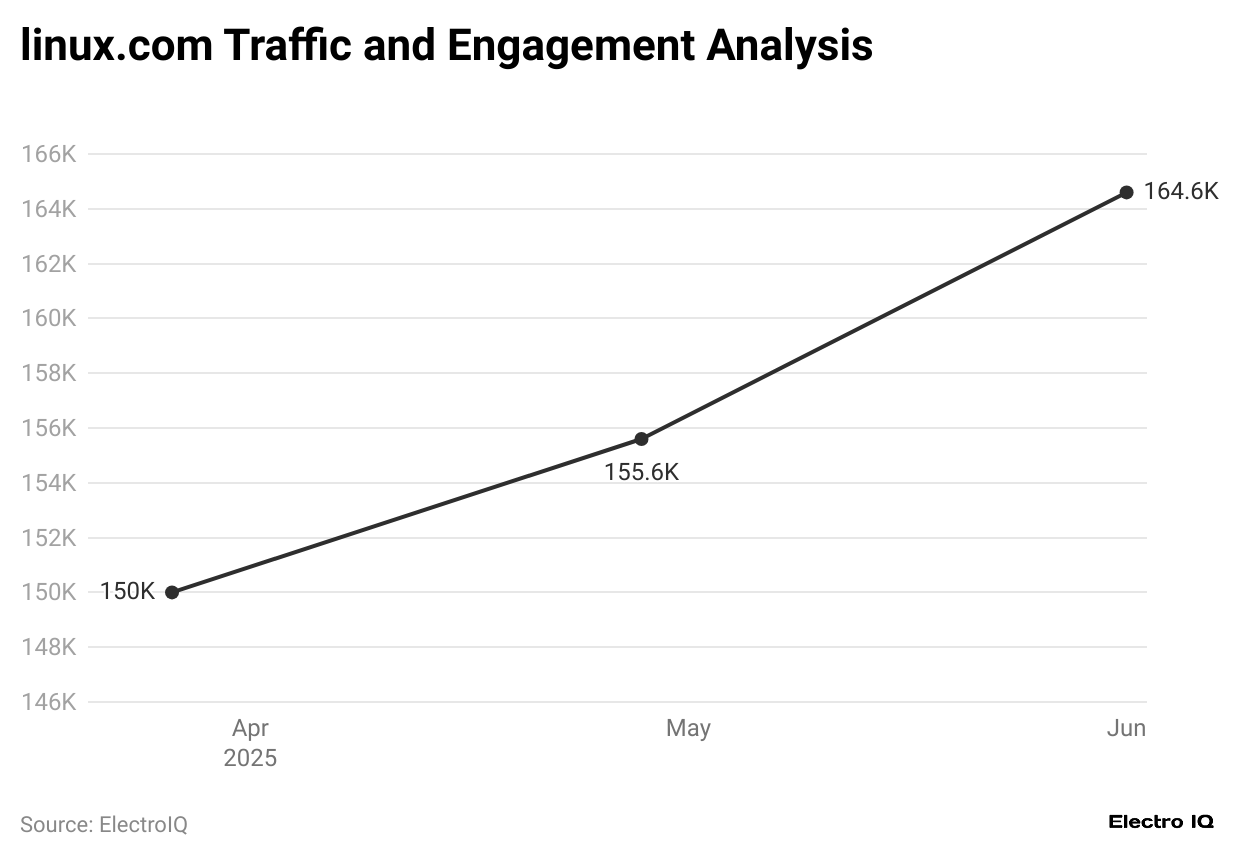
- As of June 2025, the total number of visits to linux.com was approximately 164.6K, representing a 5.82% increase from May.
- In the same period, the website’s bounce rate was 50.87%.
- Meanwhile, the average number of pages per visit was 1.54, and the average visit duration was 24 seconds.
- As of 2025, Linux.com holds a global rank of #266,434, reflecting its position among worldwide websites in terms of traffic and engagement.
- Within the United States, it is ranked at #315,973, and in its respective category, it stands at #5,724.
By Country
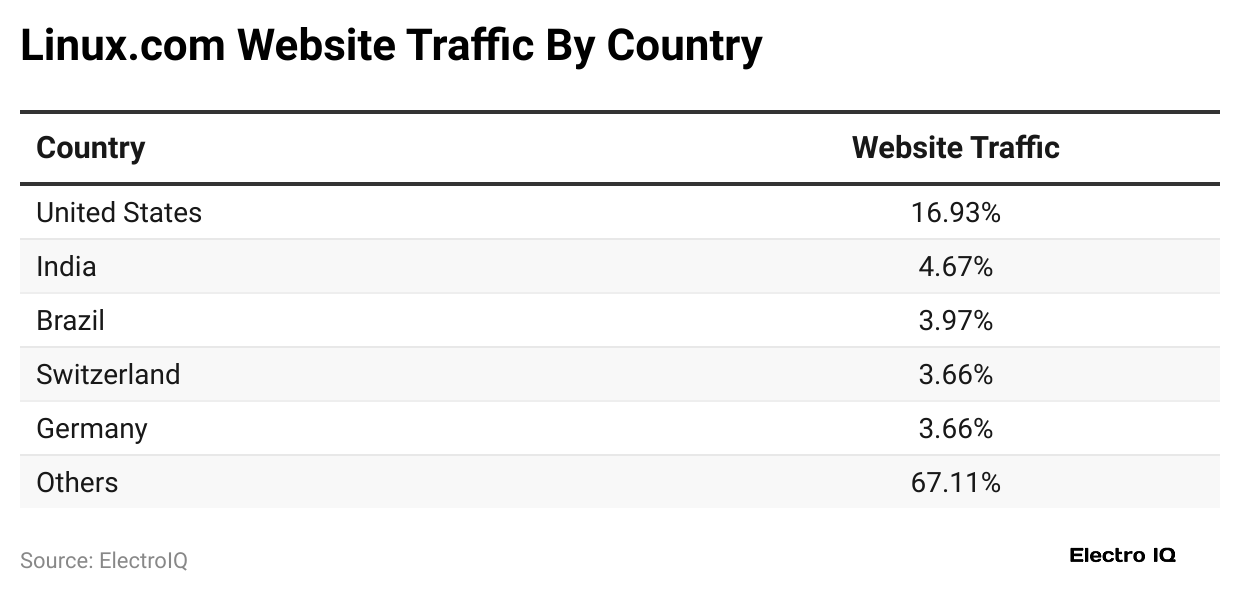
- In June 2025, the United States of America had the largest share of traffic on Linux.com, with 16.93%, an increase of 29.99% compared to the previous month.
- The next top five countries by website traffic share were: India: 4.67% (+27.12%), Brazil: 3.97% (+30.11%), Switzerland: 3.66% (+33.74%), Germany: 3.66% (+20.41%).
- The remaining countries accounted for 67.11% of Linux’s website traffic.
By User Demographics
- Linux Statistics based on gender, approximately 73.03% of Linux users were male and 26.97% female, as of June 2025.
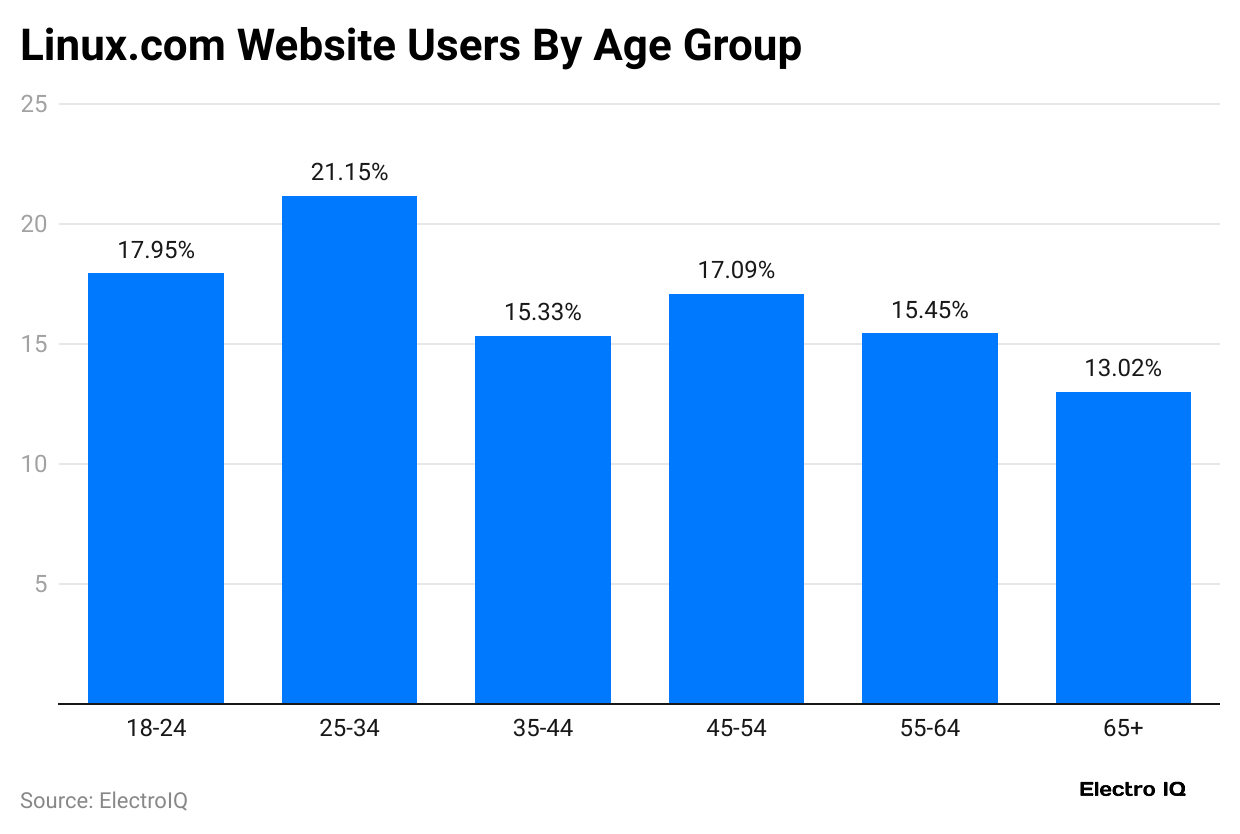
- In the same period, the total number of Linux website users aged 25 to 34 years accounted for the highest share, at 21.15%, followed by those aged 18 to 24 years at 17.95%.
- Furthermore, the age distribution of other users is as follows: 45 to 54 years (17.09%), 55 to 64 years (15.45%), 35 to 44 years (15.33%), and 65+ years (13.02%).
By Marketing Channels Distribution
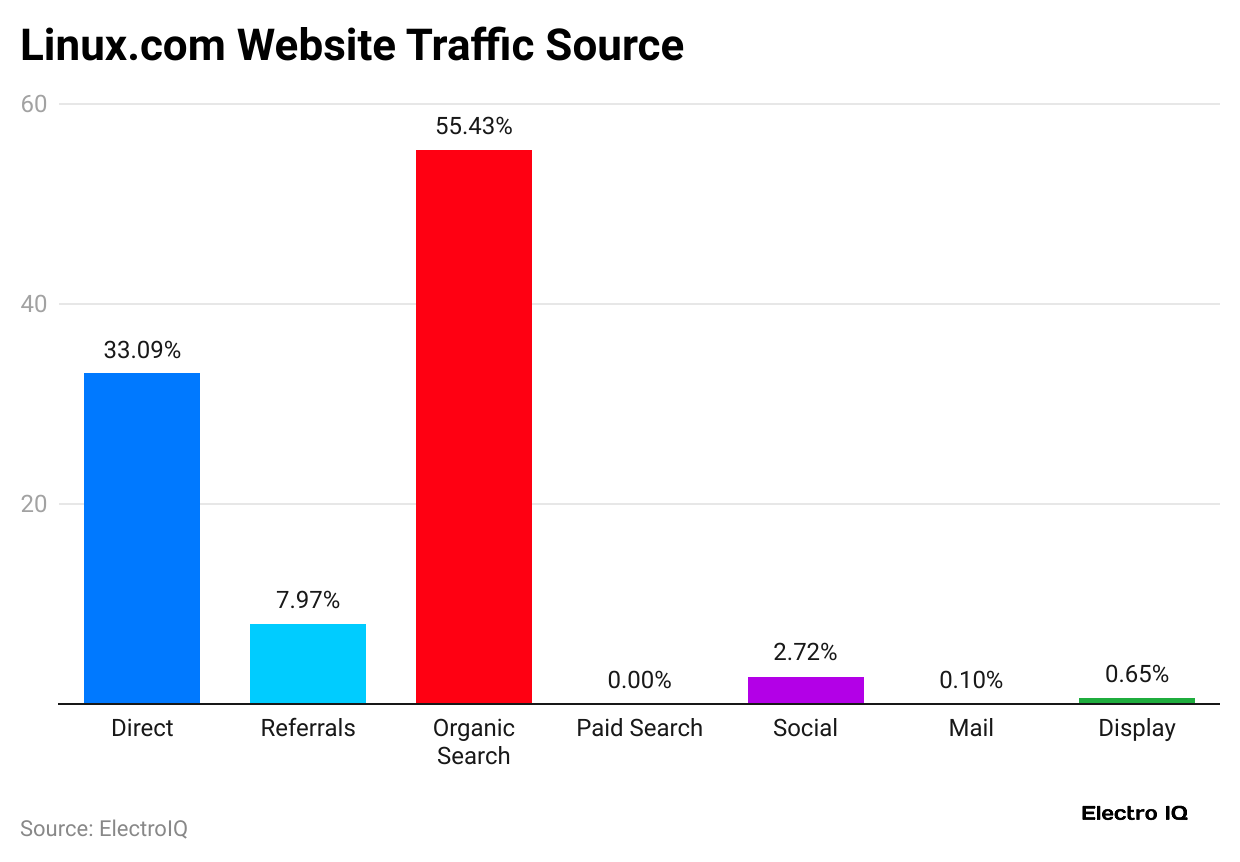
- The top traffic sources for the Linux website were captured by organic search with a traffic share of 55.43%, followed by direct search (33.09%).
- Moreover, other marketing channel distributions are followed by referrals (7.97%), social (2.72%), mail (0.1%), and display (0.65%).
By Social Media

- As of June 2025, the social network traffic accounted for by linux.com remained the highest on Reddit, holding shares of 74.67%.
- Meanwhile, X-twitter captured a share of 25.33% on the website.
5 Key Challenges to Linux Adoption Statistics in 2025
- Linux faces several challenges in 2025. With more than 600 active versions, it’s often confusing for users due to different packaging styles and support systems.
- Only about 5% of commercial software works on Linux, limiting access to popular tools like Adobe and AutoCAD.
- Nearly half of the organisations say they lack enough Linux-skilled staff.
- Many users also find Linux hard to use because it relies on commands.
- In contrast, some hardware still doesn’t work well with Linux due to missing drivers.
Advantages and Disadvantages of Linux
| Advantages | Disadvantages |
|
|
Conclusion
After completing the article on Linux Statistics, it can be concluded that Linux was started as a small personal project but has now become a strong, flexible, and safe operating system used in many fields and devices. It is open-source, backed by a large community, and fits different needs, making it popular among developers and businesses.
Though issues like too many versions and software limits still exist, Linux keeps improving and growing in various servers, cloud, and tech devices, which offer users control, freedom, and customization. All the above analyses will guide you in understanding the topic better.
Sources
FAQ.
Linux doesn’t need a paid license; it’s open-source and released under the GNU General Public License.
The six Linux runlevels define system states: 0 (halt), 1 (single-user), 2–4 (multi-user), 5 (GUI), and 6 (reboot).
Yes, Linux is often faster than Windows, basically on older hardware, due to its lightweight and efficient design.
Linux use ps aux to view all running processes from every user on the system.
As of 2025, the Linux kernel has over 30 million lines of code, constantly growing.

Maitrayee Dey has a background in Electrical Engineering and has worked in various technical roles before transitioning to writing. Specializing in technology and Artificial Intelligence, she has served as an Academic Research Analyst and Freelance Writer, particularly focusing on education and healthcare in Australia. Maitrayee's lifelong passions for writing and painting led her to pursue a full-time writing career. She is also the creator of a cooking YouTube channel, where she shares her culinary adventures. At Smartphone Thoughts, Maitrayee brings her expertise in technology to provide in-depth smartphone reviews and app-related statistics, making complex topics easy to understand for all readers.










